|
Monday, May 21, 2012
Progress Notes
In the early spring of 1956 some of the residents of Tuscumbia and the nearby area organized a community “saddle club.” The idea was inspired by a surge of interest in recreational horse back riding and rodeo events. Nearby Camdenton already had its J Bar H rodeo established in 1952 as remembered by Lake area author Dwight Weaver in his book Lake of the Ozarks Vintage Paradise 2002 (photos 01 and 02).
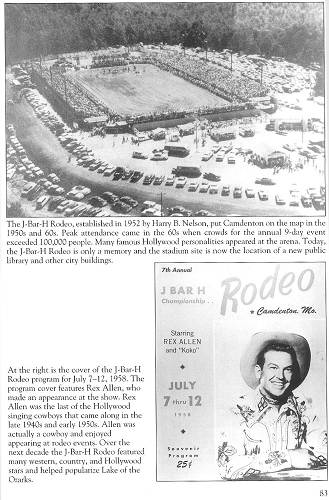
01 J Bar H Rodeo
Click image for larger view
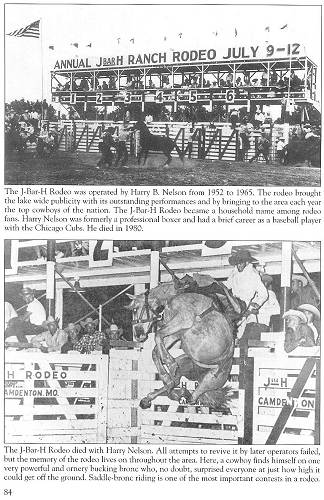
02 J Bar H Rodeo
Click image for larger view
Mechanization of agriculture had begun in the late forties and farmers gradually were beginning to buy and operate tractors to pull their plow and disc replacing the team of work horses. And the tractor also made travel over the rough farm land quicker and easier than saddling up a horse. However, a nostalgia for the horse remained, especially the saddle bred and gaited horse, and that was the inspiration for the creation of “saddle clubs” not only here but across rural America.
Having been born in the early 1940’s I occasionally saw farmers come to town in Tuscumbia with a team and wagon. Some of the Horton family drove a team and wagon to town. Also, Orb and Otto McCaslin were two brothers who regularly came by team and wagon to town as well. Here is a photo of the Patterson family of Ulman in their wagon which was used up until the 1950’s (photo 03).

03 Patterson Family Wagon
During those days most farmers still had their work horses and occasionally a saddle horse even if they also by then had bought their first tractor.
But there was a certain nostalgia among the local farmers and others which remained regarding their horses. Horse racing always had been popular, even if just for fun without any kind of organized gambling and such. And always there was somebody in the community who was known for “having a way” with horses who could train them and make them “mind.”
So as time went on some of the people around Tuscumbia began to talk about organizing a club of like minded enthusiasts which would sponsor various events to highlight the skill of the riders and the training of the horses they owned. However, land was needed to build a show arena. In 1953 Captain Bob Marshall of Tuscumbia already had donated to Tuscumbia a field he owned located just up a ways from the Riverside Park on Shut In Branch Creek. The land was to be used for community events including a baseball field which already was in place (photos 04 and 05).
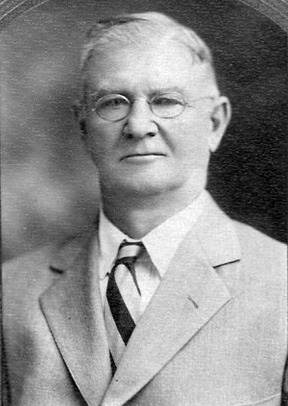
04 Captain Bob Marshall
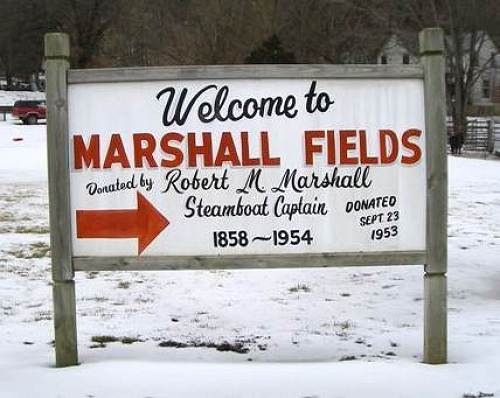
05 Captain Marshall Field Sign
So in the spring of 1956 a meeting of local area horse owners was held and the Tuscumbia Saddle club was organized. Charter members were: Elmer Slone, Mr. and Mrs. Lloyd Slone, Barney and Ernie Flaugher, Harry Flaugher, Lucille Pryor and children (Max, Jim and Linda), Clifford and Richard Hill, Mr. and Mrs. T. C. Lawson and son Bill, Mr. and Mrs. Robert Condra and son David.
Ellis and Betty Smith were two of the early members of the club (photo 06); Betty was the Secretary of the club. Here is photo of her 1958 membership card (photo 07):
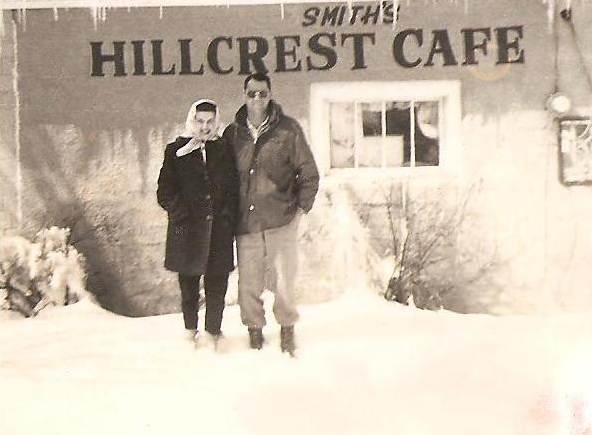
06 Betty and Ellis Smith
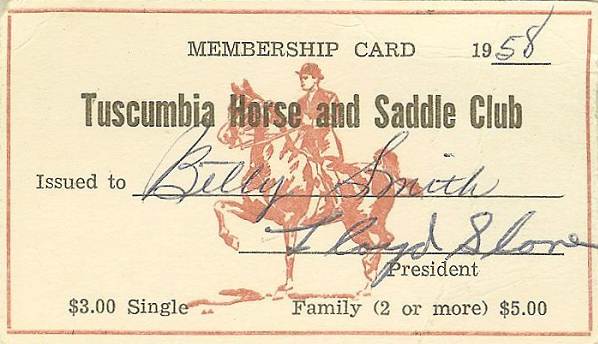
07 Saddle Club Membership Card
Betty kept many of the posters announcing events and newspaper articles about the club’s activities. She also kept the minutes of the club’s meetings (photo 08).
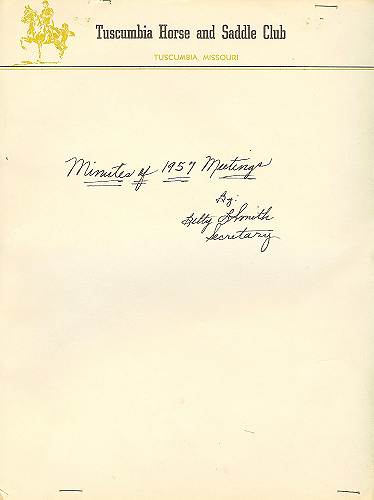
08 Minutes of 1957 Tuscumbia Saddle Club
Betty’s son, John Michael Smith, sent me some of the items saved by Betty:
Here is the poster for the first annual Horse Show and Rodeo (photo 09):
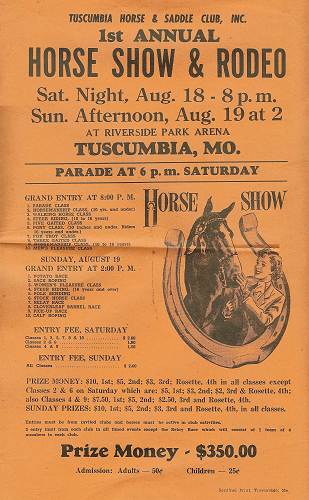
09 Horse Show Poster
Click image for larger view
And here are a few Autogram clippings describing some events and activities including one which mentions the day I joined the club (photos 10 - 13):
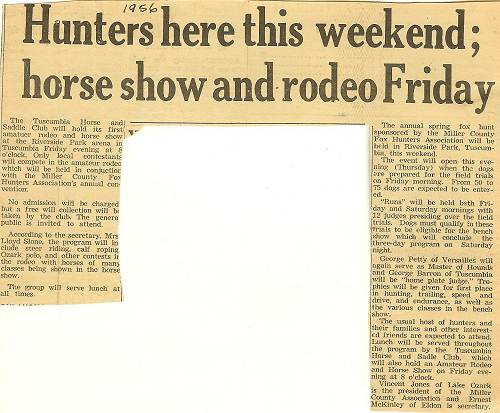
10 First Meeting - 1956
Click image for larger view
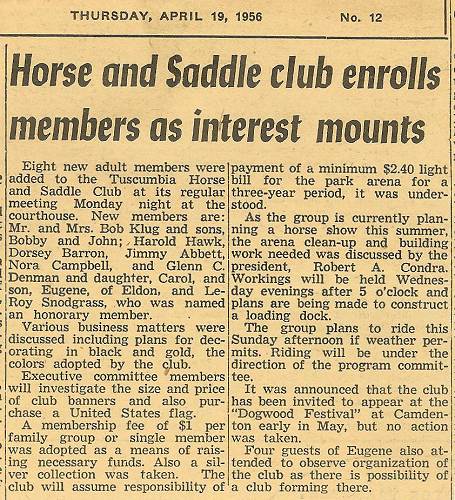
11 Interest Mounts - 1956
Click image for larger view

12 Winning Ribbons - 1956
Click image for larger view
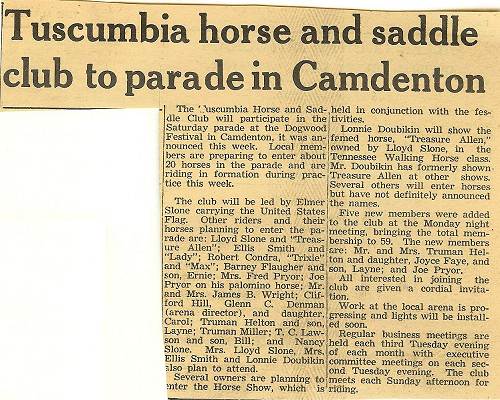
13 Joe Pryor Joins Saddle Club
Click image for larger view
John Michael also sent me some Autogram newspaper photos taken at one or more of the early events held by the Saddle Club (photos 14 - 18):
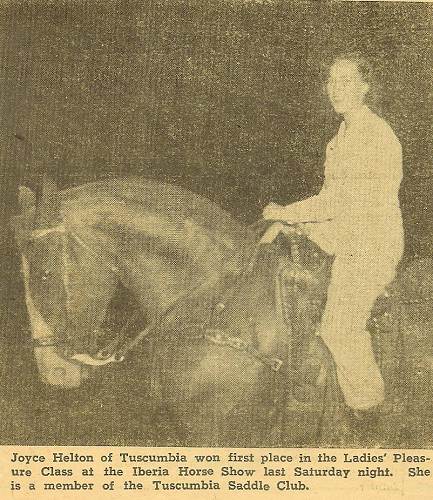
14 Joyce Helton wins First Place
Click image for larger view
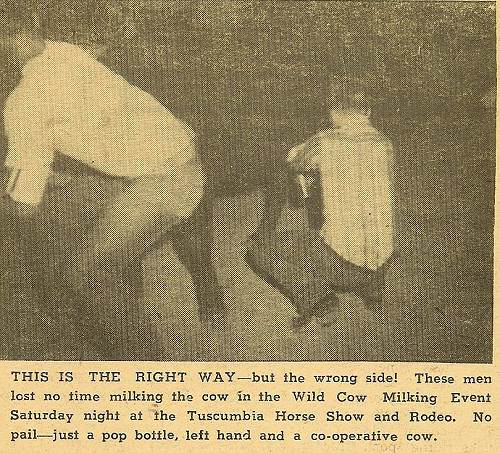
15 Wild Cow Milking Contest
Click image for larger view
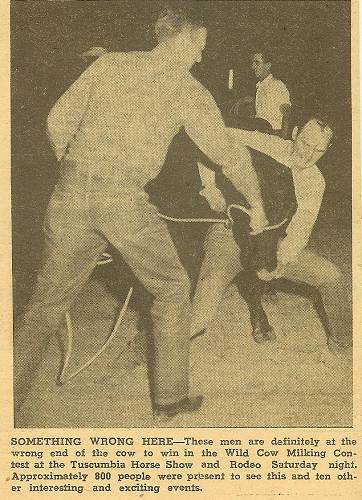
16 Wrong End
Click image for larger view
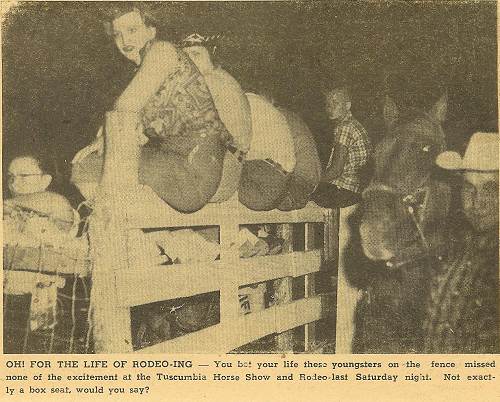
17 Fence Sitters
Click image for larger view
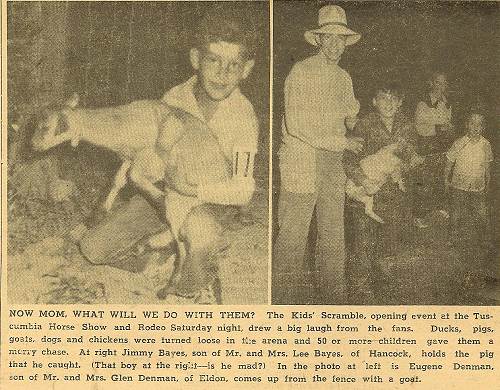
18 Kids Scramble
Click image for larger view
I was one of the early ones to join the club in 1956 although not a charter member. However, I already had some experience riding a bucking mustang in Colorado (photo 19).
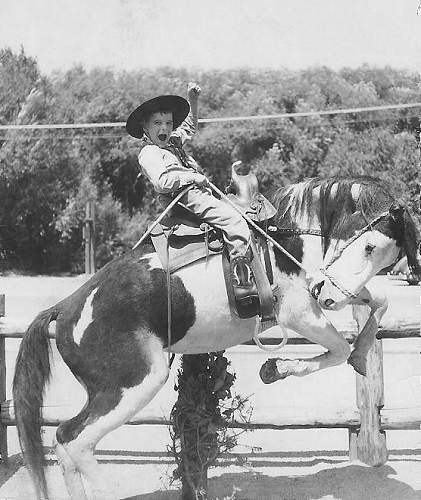
19 Joe Pryor on First Horse
Really, I am just kidding; in truth, as you probably guessed, the horse I was riding was stationary having not moved for a number of years. We found it on a family trip to Colorado at an amusement park.
Here are a couple of photos of myself on a real live horse I had when I was about 14, a cream colored palomino named Pal. The first photo was taken at the new arena in Tuscumbia and the second photo was taken at the farm my father owned then at the junction of Highways 52 and 17 (photos 20 and 21):
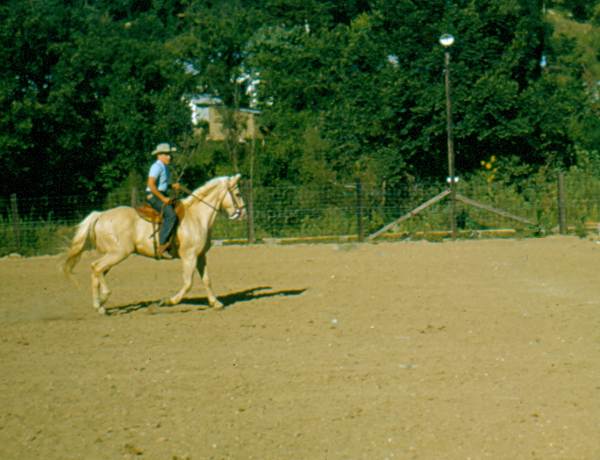
20 Joe Pryor - Tuscumbia Saddle Club Arena
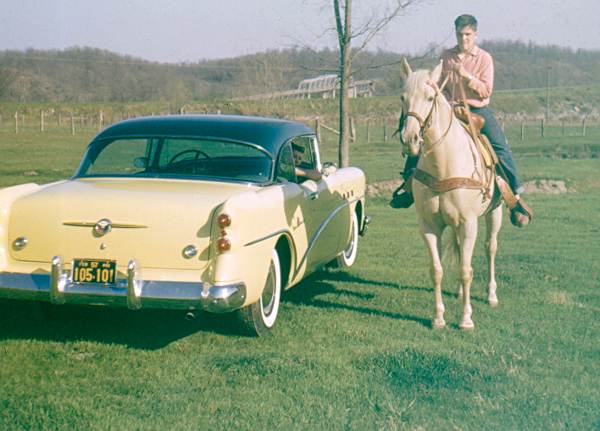
21 Joe Pryor on horse Pal on farm near 17 - 52 Jct
You can see the Osage River bridge in the background of the second photo. (And that’s my mother Susie Pryor peeking out the window.)
My cousins Jim and Max Pryor also were members of the Tuscumbia Horse and Saddle Club. Here is a photo of Jim on their horse named “Barney” (photo 22):
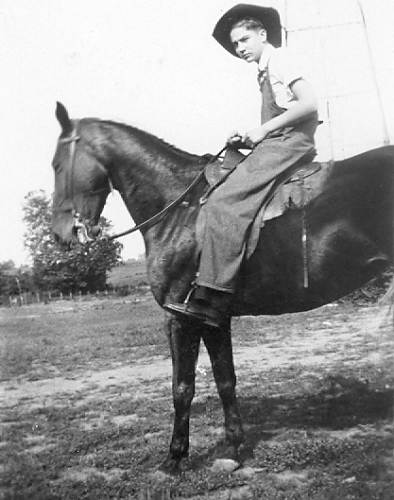
22 Jim Pryor on Barney
For quite a number of years the Tuscumbia Horse and Saddle Club was very active hosting various events and an annual rodeo as well. As you can read from the clippings members also frequently travelled as a group to attend events sponsored by other saddle clubs in the area, which had been established over the same time frame as had the one in Tuscumbia. Eventually, enthusiasm and interest in the saddle club dwindled to some extent due, I think, to the expense of keeping a horse which no longer was needed on the farm and used solely for recreational use.
Recently, our museum was visited by the Eldon Elementary School 3rd graders as part of an outing which also included a tour of the courthouse and a picnic lunch at the Riverside Park. Here are some photos taken of the children at various places in the museum and museum campus (photos 23 - 29):
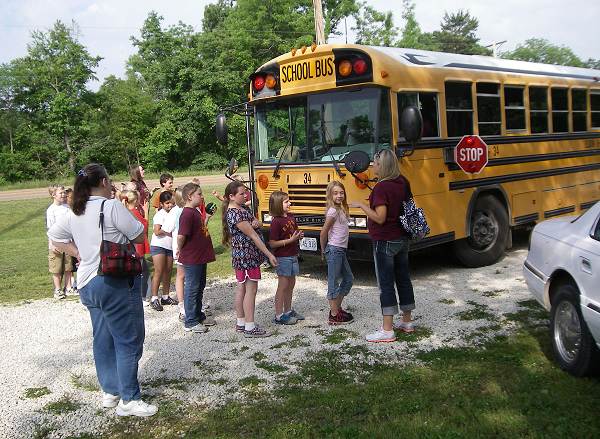
23 Arrival at Museum
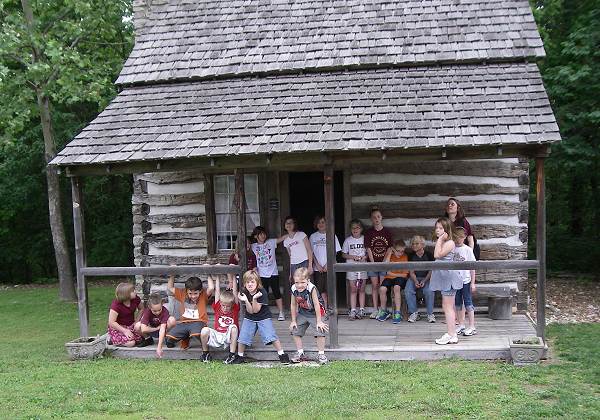
24 Posing at Lupardus Cabin

25 The Old Slave Cabin
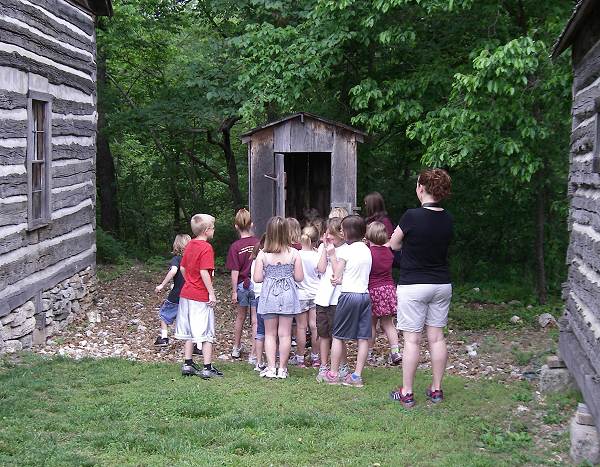
26 Great Interest in a building of Bygone Days
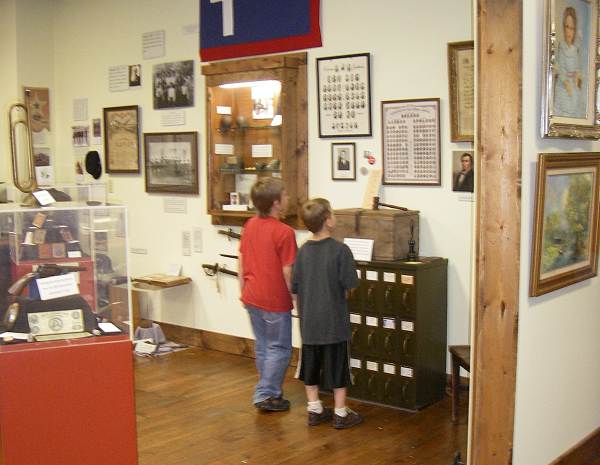
27 Civil War Display
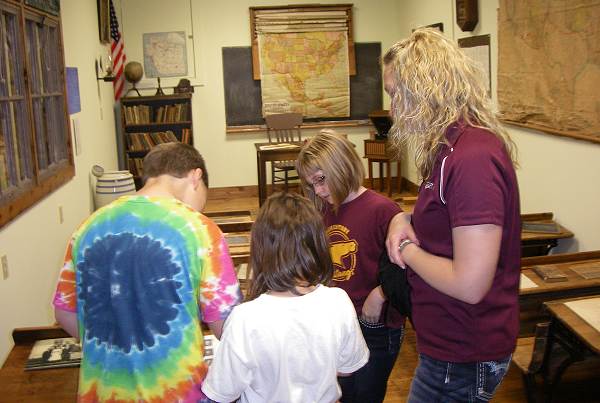
28 Old One Room School
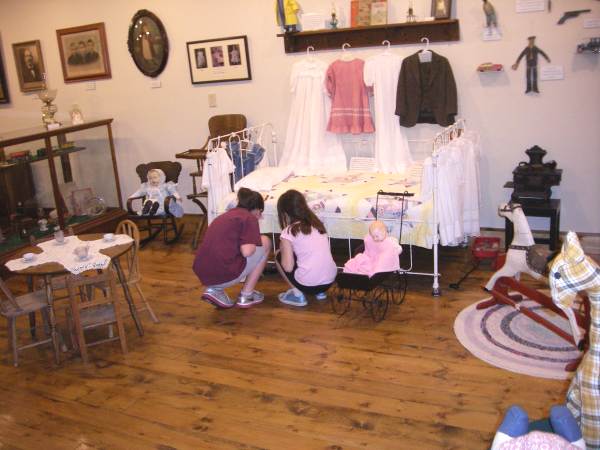
29 Viewing Childhood Bed of Helen Phillips
One child, Ethan Polly, came up to me and handed me a note his father had given him regarding the large painting of Miller County by Laura Dalton which is hanging on the east wall of the upper level of the stone building section of our museum. The note indicated that Ethan was the son of Mike Polly whose stepmother’s mother was Laura Elizabeth Dalton, the artist who painted the large mural on the wall. Here is a photo of Ethan in front of the mural (photo 30):

30 Ethan Polly
Ethan was really proud that his great grandmother, Laura Dalton, had made such a large painting for our museum, the largest, in fact, that we have on our walls. And it may be one of the most reproduced and displayed paintings of all those that have to do with our county; you may have noticed that it even is prominently displayed in the middle of the home page of our website. Here is a close up of the mural (photo 31):

31 Miller County Mural
Board member Connie Prather of Iberia has been quite busy the last week receiving very interesting items from folks around the Iberia area for display in our museum. Last week she brought over some remnants left from the deconstruction of the old Buechter Bridge which recently has been replaced (photo 32).
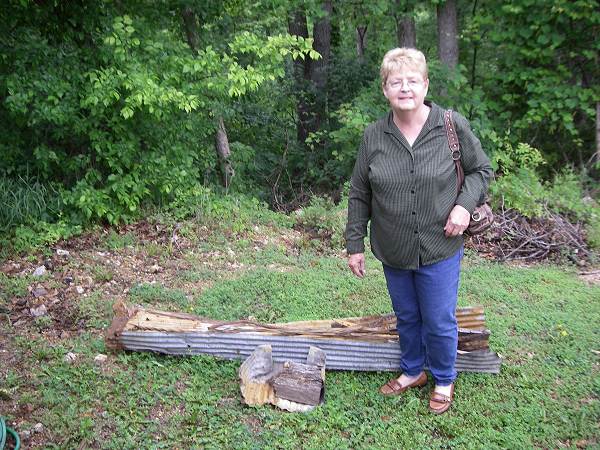
32 Connie Prather with remnants of Buechter Bridge
The Buechter Bridge was a suspension bridge completed in 1910 located near St. Anthony on Buechter Bridge Road in Miller County.
It was built by Joseph Dice having a 141.0 ft. length with a width 12.1 feet and a clearance 9.1 feet. It was taken down last November 1st, 2011.
Prior to the take down of the old bridge Joey and Tiffany Wright of Iberia took a number of photos of the old bridge which they donated to our museum. They fixed the photos to a finished wooden backing which we immediately placed on display in our bridge history area of the museum. Here is a photo Joey took of the Buechter Bridge shortly before it was removed (photo 33):
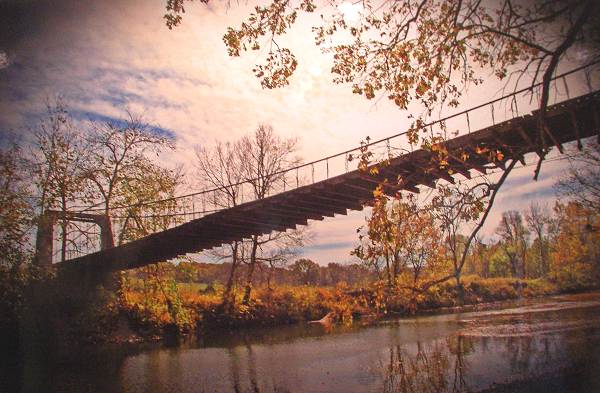
33 Buechter Bridge before Demolition
And here is a photo of the Buechter Bridge display donated by Joey and Tiffany now on display (photo 34):
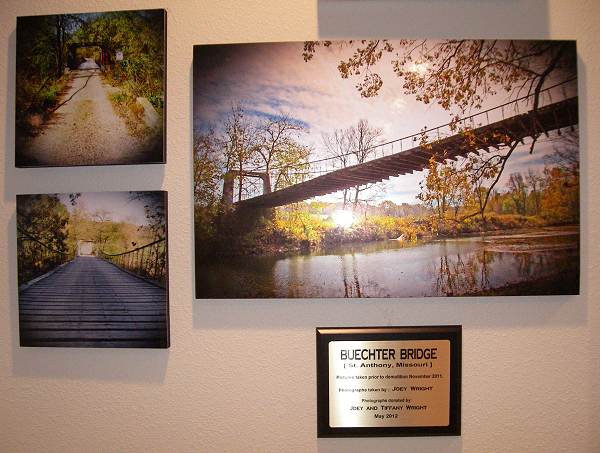
34 Wall Display of Buechter Bridge
A closer look at the descriptive identification plaque is in this photo (photo 35):
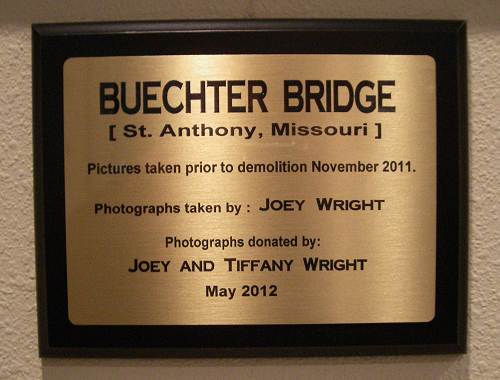
35 Information Plaque
We are very grateful to Joey and Tiffany for this very important and interesting collection of photos of the historical Buechter Bridge. Joey is a grandson of Wanda Wright who is one of our board members.
Connie also brought us four antique chairs from the Iberia Masonic Lodge, not only just for display but also because we will use them for guests to sit on during our public events. In this next photo Connie displays two of the wooden chairs which were obtained for the Lodge about 1918-1920 (photo 36):
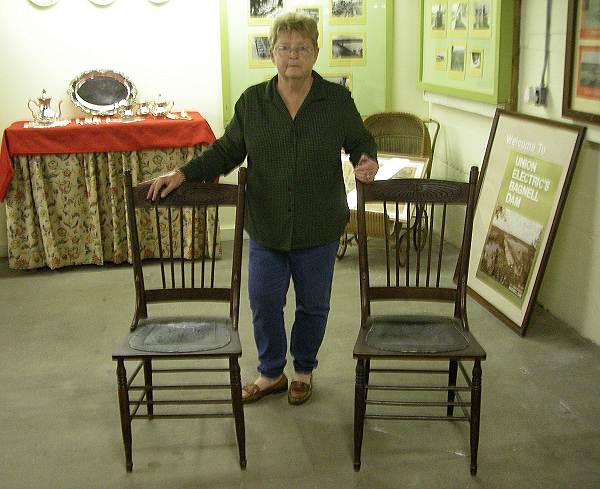
36 Wooden Chairs are from 1918 - 1920
The two other chairs donated are Wicker bottom chairs which date from 1872 (photo 37).

37 Wicker Bottom Chairs date from 1872
Connie informed me that The Iberia Masonic Lodge #410 opened its doors in 1872 and now is 140 years old, standing on its original foundation. On June 2, 2005 a new lodge was added. Connie remarked that “being a mason is a way of life in which high ideals and moral character are exemplified but is not a religious or political organization.”
Recently, Anita Rogers of Eldon gave me an old bottle made many years ago by the Eldon Bottling Works (photo 38).
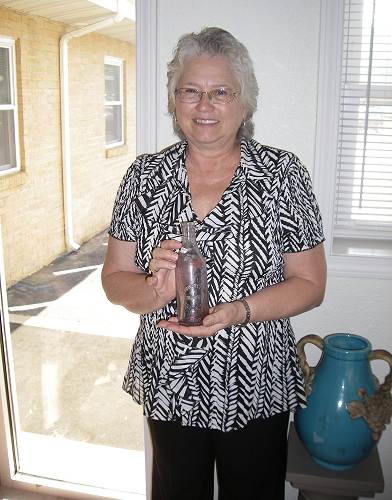
38 Anita Rogers with Eldon Bottle
Anita said she originally had kept the bottle in a shop she owned which featured various kinds of art and pottery.
I have presented the story of the Eldon Bottling Works in a previous Progress Notes taken from an old edition of the Eldon Advertiser which I will copy here:
Eldon Bottling Works
One of the strong, growing and thriving lines of business of this city and one covering a wide and prosperous territory in its operations is the Eldon Bottling Works (photo 39), of which Mr. W. R. George is proprietor and manager.
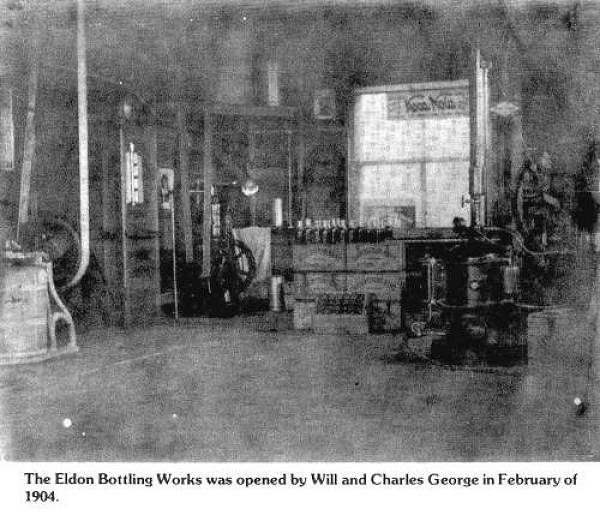
39 Eldon Bottling Works
Mr. George established this business five years ago and by vigorous attention and sound management has pushed it up into one of the leading lines of business of the city and community. In this factory is manufactured soda pop, ice cream and all kinds of carbonated drinks. A general jobbing business is done over a large section and a specialty is made of filling rush orders and making prompt shipments on short notice. The ice cream manufactured here has earned a wide reputation for its excellent qualities and the first class condition in which it reaches customers. A feature of the factory is the sanitary conditions that prevail on every hand. All of the packers or receptacles in which ice cream is shipped are porcelain lined thus insuring absolute cleanliness and purity. A specialty is also made of furnishing ice cream suppers, socials and other functions with cream, either in Eldon or in any other town in the large territory in which shipments are made.
Mr. George's factory charges tanks for soda fountains and furnishes flavored syrups for these fountains. He also keeps extracts.
This establishment has the latest and most modern machinery and its service toward patrons is such as to make it one of the most reliable as well as one of the successful lines of business of the city.
We have now three of the old bottles from the Eldon Bottling Works factory in our museum. We appreciate the willingness of Miller Countians to share with us their artifacts having to do with the history of Miller County.
Another enterprise very important to Eldon years ago was the coming of the freight trains. I found a short history of the coming the railroad to Miller County in the Advertiser sesquicentennial edition of 1976:
Railroads Come To Miller County
Eldon Advertiser Bicentennial Edition 1976
Coming of railroads to Miller County—20 years apart---played key roles in the county’s history, development and growth.
First was the line that was to become known as the Bagnell Branch of the Missouri Pacific in the early 1880’s, with stations established roughly five miles apart between Jefferson City and Bagnell (photos 40, 41 and 42).
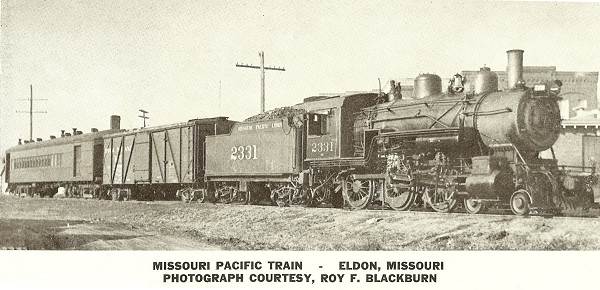
40 Missouri Pacific Engine
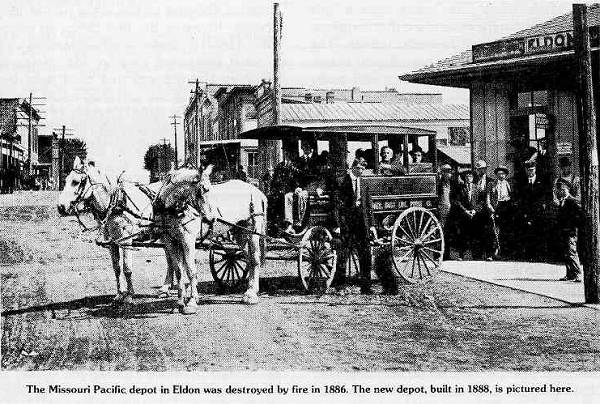
41 Missouri Pacific Depot in Eldon - 1888
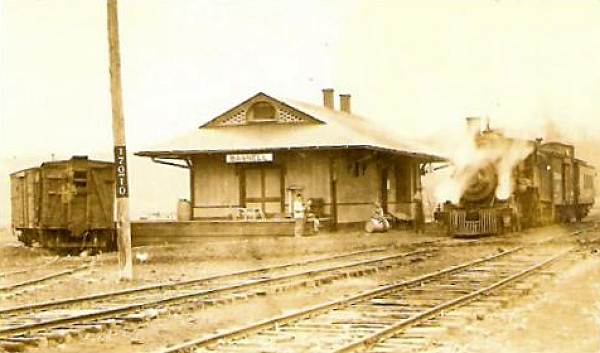
42 Bagnell Depot
Then, after the turn of the century, rails began moving westward for what was to become the main line of the Rock Island with its division point in Eldon (photo 43).
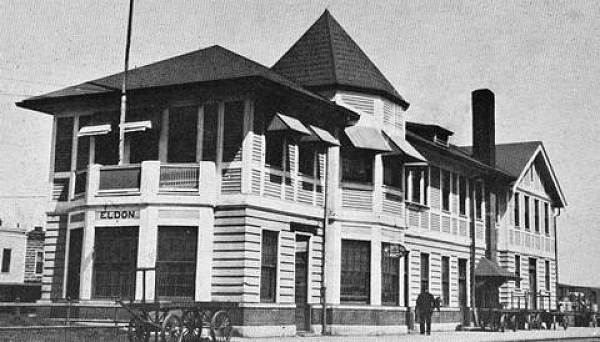
43 Rock Island Eldon Depot
Here is a photo of a crew working on the Becker Cut in Miller County west of Eugene (photo 44):
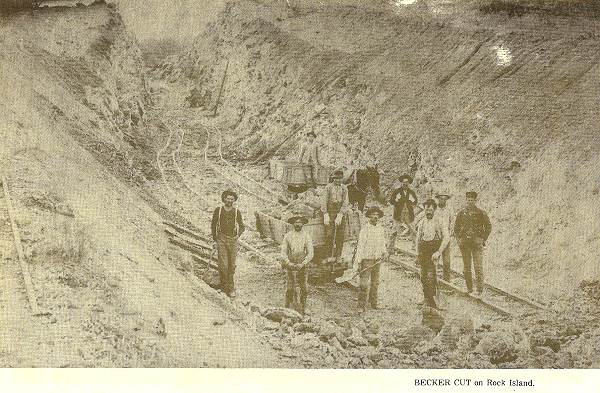
44 Becker Cut Crew on Rock Island Railroad
Standing on the cart in the background is M.O. (Doc) Henley and on the other cart his younger brother, Arnold. The man at the far left is identified as Bill Rush and, third from right with the shovel is George Sullens.
M.O. Henley, 90 years of age, who lives in the Gageville community southeast of Etterville, recalls he attended Flint Rock School in the Dooley District, but quit school at 16 to work for Emil Becker of Spring Garden on the railroad construction. Becker had a contract with the new railroad to open up the dividing ridge between the Osage and Missouri rivers, known since as the “Becker Cut.”
“My brothers, Luke and Arnold, also worked,” he told Clyde Lee Jenkins, county historian. “Times were pretty hard in the year 1901, and people thought they were getting rich making $1.50 a day.” The going rate, he recalled, was 15 cents an hour for a 10 hour day; 30 cents an hour with a horse.
The next photo shows a Sunday at the Eugene tunnel, a favorite sightseeing trip on a Sunday afternoon to see the railroad progress (photo 45).
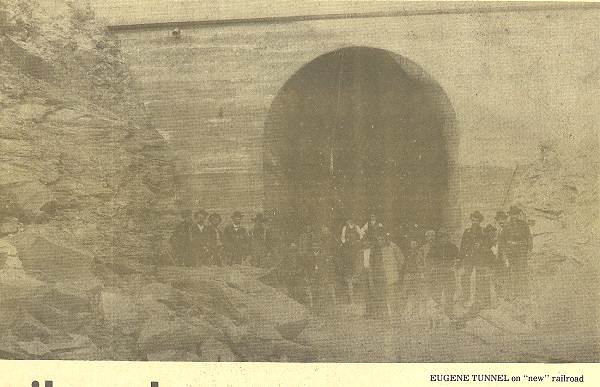
45 Eugene Tunnel on new Railroad
M.O. Henley also helped haul sacks of cement from a Missouri Pacific Railroad car at Olean to Eugene for the new tunnel. At Olean 20 or 30 sacks would be loaded in a wagon, then driven to the tunnel site and unloaded, about a one trip a day detail. From 10 to 20 wagons, pulled by four horse teams made the trip daily carrying the cement.
Continuing with stories around the Eldon area, most people who come into Eldon from the south on old Highway 52 will have seen the highway sign for West Aurora on the right side of the highway. But if you take the gravel road to the left off Highway 52 you won’t find West Aurora anymore; at least, I don’t remember ever seeing a sign on the gravel road indicating where it might have been located. I presume it originally was near where the VFW lodge is now; the lodge is located on a gravel road named West Aurora which veers off to the left.
A few months ago I did write the following short paragraph in a previous Progress Notes.
“The Missouri Pacific Railroad station was located about a half mile southwest of Aurora Springs and it was here the town of West Aurora sprang up. It was laid out by A.J. Armstrong in 1882. P.J. Davidson had the first store here and also operated a large tie contracting business. A hotel and blacksmith shop opened there. Stock, lumber and ties were the chief shipments from the West Aurora depot which by 1889 reported about $120 express and $550 freight receipts a month.”
Recently, I came across three photos of buildings that existed in West Aurora which now are no longer present. These photos had been published in the Sesquicentennial Edition of the Advertiser which has supplied quite a lot of information for this week’s edition of Progress Notes. Here are the three photos with captions that are self explanatory (photos 46, 47 and 48):
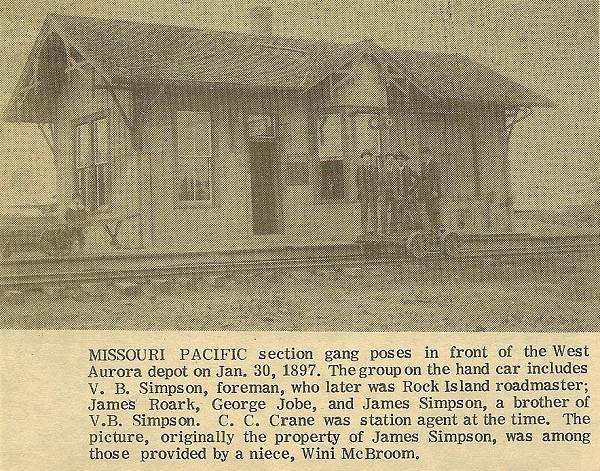
46 Missouri Pacific Station - West Aurora

47 West Aurora Public School
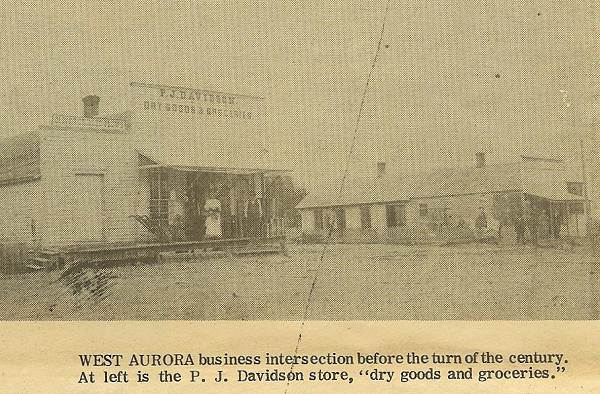
48 West Aurora Business Area
Apparently, after the Missouri Pacific railroad spur to Bagnell was discontinued, West Aurora was not far behind.
Last Saturday, May 19, the Miller County Museum opened for the summer. The day was a special one this year as we participated in the Jason Ash Memorial Dedication Ceremony and the Miller County Veterans Tribute. A welcome address was given by Ken Thompson, representing the Jason Ash Memorial Foundation (photo 49).

49 Ken Thompson
The guest speaker was Tom Wright, who is Presiding Commissioner of Miller County (photo 50).
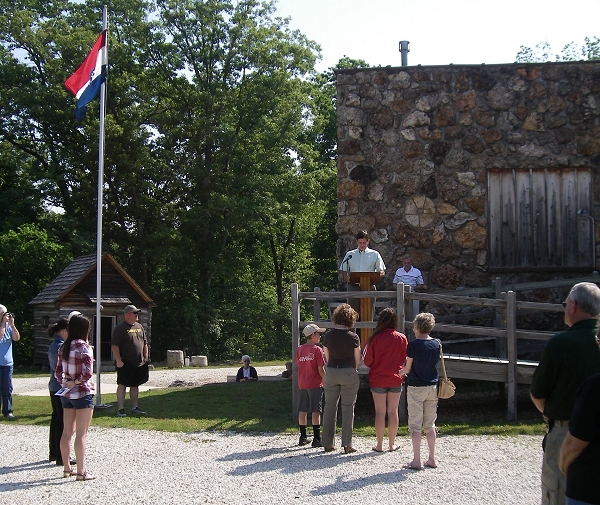
50 Tom Wright
You can read his speech here (photo 50a):
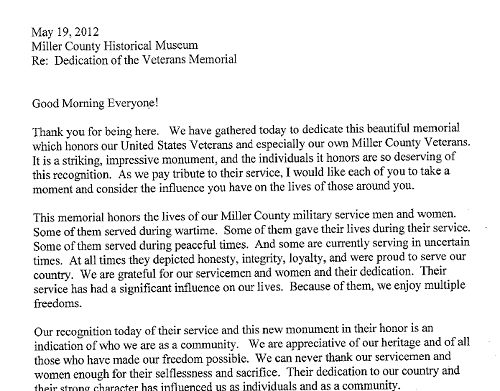
50a Tom Wright Speech
Click image to read entire speech in PDF format
A flag raising ceremony was presented by local soldiers in uniform accompanied by the singing of the Star Spangled Banner by Samantha Dawn (photos 51 and 52).
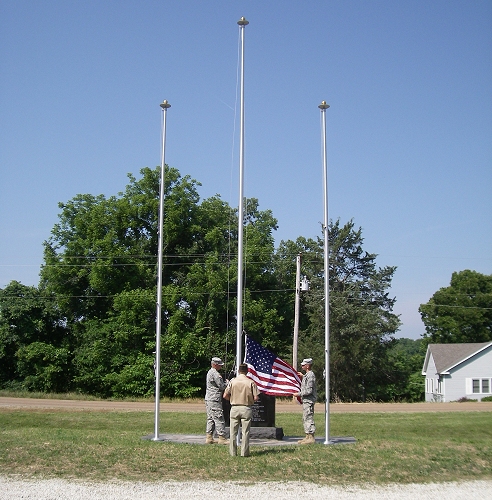
51 Flag Raising

52 Flag Raising
“Taps” and a gun salute were given by members of VFW Post 2442 (photo 53).
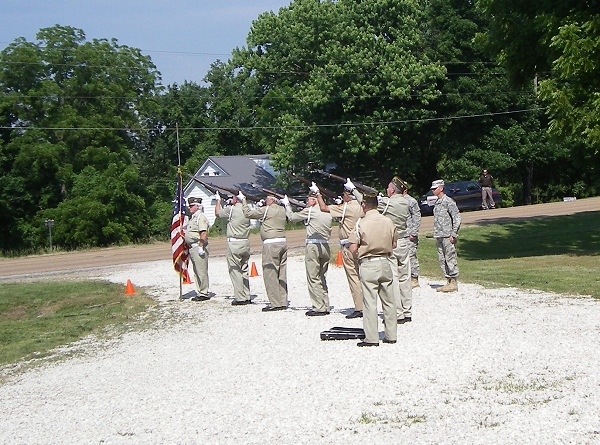
53 Taps and Gun Salute
The five flags raised represented the U.S. Army, Air Force, Navy, Marines and Coast Guard (photo 54).
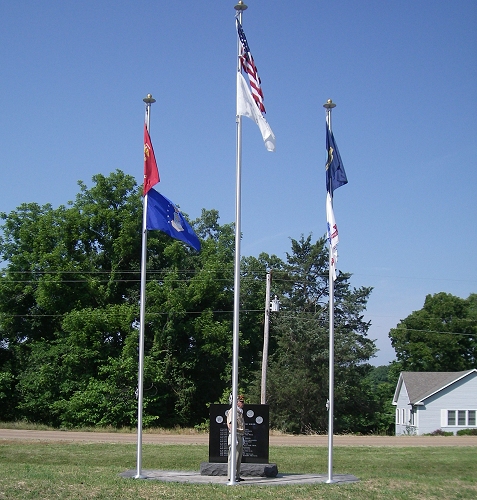
54 Five Flags Flying
After the Memorial Dedication Ceremony the museum was opened for the season. Visitors were served various deserts including cookies, cake and pie and were entertained by the Joe Jeffries musical group (photos 55 and 56).

55 Enjoying desserts and music by Joe Jeffries Group
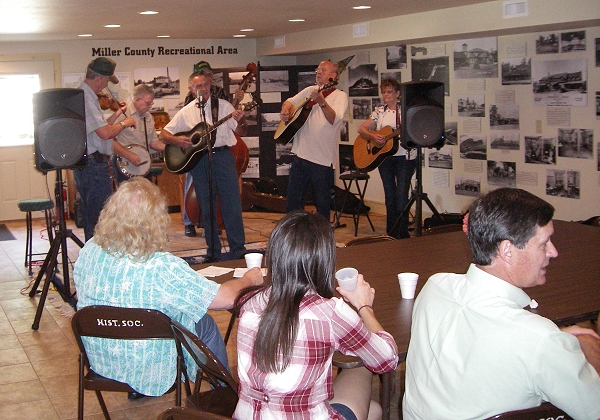
56 Joe Jeffries Group
Because of a number of conflicting circumstances I find that I no longer have the time to continue writing the Progress Notes column for our website. However, more than 250 previous Progress Notes are available in our archives which you will find at the top of this page. Since the historical part of each week’s Progress Notes is timeless those who have not followed the series of articles each week from when the first one was written in April of 2007 can have the opportunity to refer to the archives to read previous editions.
However, I will continue to write a short note weekly during the summer season to keep readers abreast of current events at our museum.
That’s all for this week.
 Joe Pryor
Previous article links are in a dropdown menu at the top of all of the pages.
|

